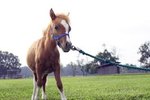If your veterinarian has suggested a potential diagnosis of spinal stenosis, also referred to as lumbosacral stenosis or cauda equina syndrome, this means that your canine companion’s pain, stiffness or lameness may be caused by a compression of his spinal nerves. This condition is degenerative, and the symptoms worsen as the disease progresses. Depending upon the severity of your dog’s symptoms and the cause of the compression, various treatment options are available to minimize the symptoms and extend his quality of life.
Spinal Stenosis Explained
Your dog’s spinal cord and connected nerve roots are contained within the spinal canal. When this canal narrows, compression on the spinal nerve roots results. The most typical area for this compression to occur is in the lumbosacral region where the pelvis and spine are connected, which is why the symptoms of spinal stenosis affect hind end function and mobility. Spinal stenosis can be a congenital condition, but it is more typically acquired later in life as the result of degenerative arthritis of the spine or intervertebral disc herniation. Spinal stenosis commonly afflicts large breeds, such as German shepherds and Rottweilers. Other causes of spinal compression include tumor growth in the spine and injury resulting from trauma.
Symptoms of Spinal Stenosis
The compression of spinal stenosis is painful and debilitating. Dogs who are afflicted will show reluctance to mount stairs, jump into the car or climb on furniture. Lameness and weakness when walking and difficulty getting into the usual stance for defecation are typically observed as the rear leg muscles atrophy from minimal use. Your dog may appear stiff and slow to get up or lie down, and he may no longer be able to wag his tail when you greet him. Some dogs yelp if they make a move that incites pain. As the condition advances, neurological signs set in, including fecal and urinary incontinence.
Diagnosis of Spinal Stenosis
Once your veterinarian has performed a general physical examination and some simple neurological function tests to isolate your dog’s source of pain, she will likely order radiographs of the spine. An advanced diagnostic imaging test, such as an MRI, CAT scan or electromyography, will confirm the definitive diagnosis of spinal stenosis. These tests, combined with your dog’s history and basic laboratory blood and urine test results, will also shed light on the cause of the disease. Once the diagnosis and the cause of the disease have been determined, your veterinarian will discuss your dog’s symptoms and propose a treatment plan.
Medical Treatment Options
The milder symptoms of spinal stenosis can be managed with anti-inflammatory drugs and pain management medications. Cases that are mild or diagnosed early respond favorably to such treatment, but this conservative approach only offers some relief from the symptoms in more advanced cases. Alternately, your veterinarian may discuss the use of corticosteroid injections to treat your canine friend. These injections are administered directly into the lumbosacral spinal canal, and their anti-inflammatory quality is an effective treatment method for relieving the compression and symptoms of spinal stenosis. These epidural corticosteroid injections provide another form of treatment for owners and veterinarians who prefer to opt for surgery only as a last resort.
Surgical Treatment Options
If your dog’s symptoms worsen or do not improve, your vet may recommend surgical intervention to relieve the spinal compression. The procedure, which is called a dorsal laminectomy, involves creating an opening on the spine through which the nerve roots can move more freely as compression is relieved. During the procedure, the surgeon will remove the source of the compression, if possible, and she may also fuse any unstable vertebrae to prevent additional compressions in the future. The goal of this procedure is to relieve the compression of the nerve roots and reduce the pain, but not all patients regain full neurological function. Post-operative home care will include strict rest for several weeks, but your veterinarian may provide you with simple home physical therapy exercises to help your dog maintain his ambulatory status. Follow your veterinarian’s guidelines to the letter to prevent complications.
Lifestyle Changes
Your veterinarian will prescribe a regimen of lifestyle changes to prevent your dog’s condition from being aggravated further. Certain movements and activities, such as jumping, running or heavy exercise, place extra pressure on the spine, so leash-walking while outdoors and confinement when indoors may be recommended. If your buddy is pleasingly plump, a weight loss diet may be in order to slim down and reduce the pressure of extra weight on his spine. Close monitoring and communication with your veterinarian will enable you to address symptoms as they arise. Early diagnosis and treatment of spinal stenosis provide a good prognosis for an improved quality of life.
References
Photo Credits
-
predrag1/iStock/Getty Images




